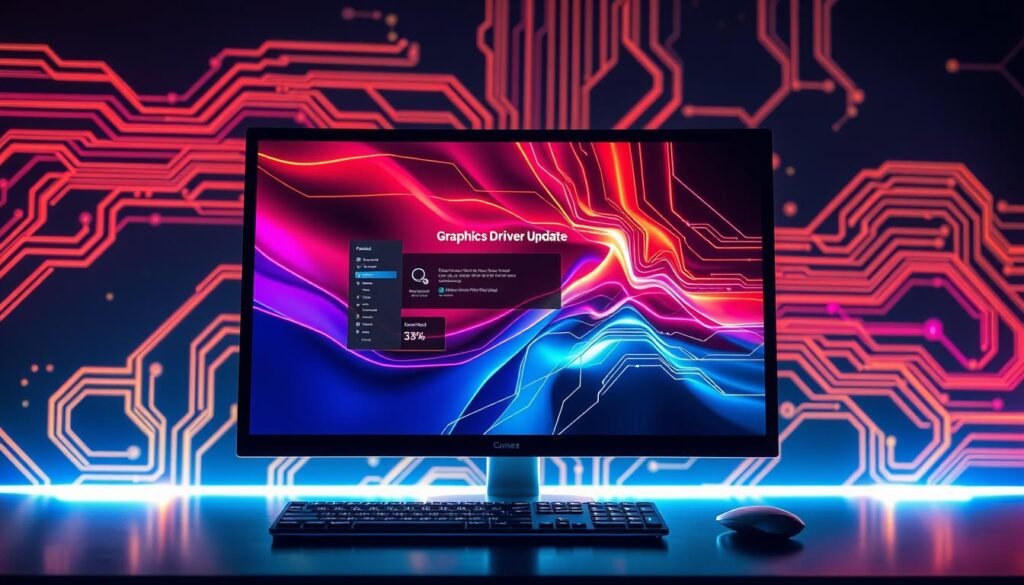Are you seeing slow performance, system crashes, or issues with compatibility on your Windows PC? Outdated graphics drivers might be the problem. It’s key to keep your graphics drivers current for the best PC performance, better gaming, and system stability. This guide will show you how to update your graphics driver in Windows. You’ll also get tips to keep your system running smoothly.

Key Takeaways
- Graphics drivers are essential software that allow your computer to communicate with your graphics hardware, such as your GPU.
- Updating your graphics drivers can improve system performance, fix compatibility issues, and ensure your hardware is utilizing the latest features and security patches.
- There are multiple ways to update your graphics drivers, including using Windows Update, Device Manager, and downloading directly from the manufacturer’s website.
- Regularly checking for and installing graphics driver updates can help prevent system crashes, hardware malfunctions, and other performance-related problems.
- Keeping your graphics drivers up-to-date is a simple yet effective way to enhance your overall PC experience, particularly for gaming and multimedia applications.
What is a Graphics Driver and Why Should You Update It?
Device drivers are key to your computer’s smooth operation. Graphics drivers, in particular, help your computer’s graphics hardware and software talk to each other. This ensures your system runs well and looks great. It’s important to keep your graphics drivers updated for the best performance.
Understanding the Role of Graphics Drivers
Graphics drivers connect your computer’s graphics hardware to the software you use. They make sure the graphics hardware can understand the software’s instructions. This lets your computer show images, videos, and more smoothly.
Benefits of Keeping Your Graphics Drivers Updated
Updating your graphics drivers often has many benefits. Manufacturers release updates to fix bugs, boost performance, and add new features. Keeping your drivers current means your system can use the latest graphics technology. This leads to better graphics, smoother games, and a better user experience. Updated drivers also help protect your system from security threats.
In short, updating your graphics drivers is crucial for your computer’s graphics hardware. It keeps your system stable, improves visual quality, and brings you the latest features and security updates.
How do you update your graphics driver?
Keeping your graphics driver updated is key for your system’s best performance and stability. Luckily, there are a few ways to make sure your graphics driver is always current.
Updating Drivers Using Windows Update
Updating your graphics driver through Windows Update is easy. Windows Update checks for and installs the latest driver updates, including for your graphics hardware. To do this, open the Windows Update settings, click “Check for updates,” and let Windows do the work. This method keeps your drivers, including your graphics driver, up-to-date with little effort.
Updating Drivers with Device Manager
For more control over your device drivers, use the Windows Device Manager. Open the Device Manager, find your graphics card, right-click on it, and choose “Update driver.” This will make Windows search for and install the latest driver for your graphics hardware. This method gives you more control over the update process but might need more steps than Windows Update.
By using these methods, you can keep your graphics driver updated. This ensures your Windows system runs at its best performance and stability.
Troubleshooting and Advanced Methods
If your computer is slow or crashes often, it might need a graphics driver update. Problems like devices not working right or system errors are signs too. These issues show your graphics driver is outdated and needs fixing.
Graphics drivers are key for your computer’s graphics to work well. Old or wrong drivers can cause big problems. Keeping your driver updated helps avoid these issues and keeps your system running smoothly.
To fix these problems, update your graphics driver. You can do this through Windows Update, Device Manager, or the manufacturer’s website. Updating your driver ensures your computer runs better and more reliably.
Ensuring Optimal Graphics Performance
Updating your graphics driver is key to top-notch graphics on your Windows PC. But, don’t forget about game settings, system config, and hardware too. Keeping drivers current and tweaking settings boosts app and game visuals, making your experience better.
For instance, setting your Windows Power Options to “High Performance” gives your GPU the power it needs. Also, using Radeon Anti-Lag and Radeon Chill can cut down on lag and save power. These steps enhance your system’s performance.
The performance overlay, activated by Ctrl + Shift + O, shows real-time data like FPS, GPU usage, and temps. This info helps spot performance issues. Most gamers aim for 60 FPS, but some prefer higher refresh rates for smoother gaming.

